Yauco, Puerto Rico
Yauco (Spanish pronunciation: [ˈʝawko]) is a city (ciudad) and municipality in southwestern Puerto Rico, centered on the city of the same name. Although the city is inland, the municipality stretches to a southern coast facing the Caribbean Sea. Yauco is located south of Maricao, Lares and Adjuntas; east of Sabana Grande and Guánica; and west of Guayanilla. The municipality consists of 20 wards plus the main city Yauco zona urbana (Yauco Urban Zone). It is both a principal city of the Yauco Metropolitan Statistical Area and the Ponce-Yauco-Coamo Combined Statistical Area.
Yauco Municipio de Yauco | |
|---|---|
City and Municipality | |
Yauco's Plaza Fernando Pacheco | |
 Flag 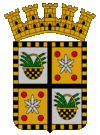 Coat of arms | |
| Nicknames: | |
| Anthem: "Pueblo de gestas gloriosas" | |
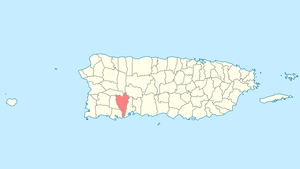 Map of Puerto Rico highlighting Yauco Municipality | |
| Coordinates: 18°2′13″N 66°51′1″W | |
| Commonwealth | |
| Founded | February 29, 1756 |
| Wards | |
| Government | |
| • Mayor | Angel Luis "Luigi" Torres Ortíz (PNP) |
| • Senatorial dist. | 5 – Ponce |
| • Representative dist. | 21,23 |
| Area | |
| • Total | 68.8 sq mi (178.1 km2) |
| • Land | 68.1 sq mi (176.5 km2) |
| • Water | 0.6 sq mi (1.6 km2) |
| Population (2010) | |
| • Total | 46,384 |
| • Density | 670/sq mi (260/km2) |
| Demonym(s) | Yaucanos |
| Time zone | UTC-4 (AST) |
| ZIP Code | 00698 |
| Area code(s) | 787/939 |
| Major routes | |
| Website | www |
It was founded by Fernando Pacheco on February 29, 1756, and developed for commodity crops of tobacco, sugar cane, and coffee. Yauco became a center for Corsican immigration to Puerto Rico in the 19th century due to its geographical similarity to their homeland. Corsicans have contributed to many areas of life in Yauco, particularly to its coffee industry. This has played a role in the city's nicknames of El Pueblo del Café (City of Coffee), and Los Corsos (The Corsicans). It is also known as La Capital Taína (the Taíno capital) after the native peoples of Puerto Rico.
History
The city of Yauco was named after the river Yauco, which the indigenous Taíno called coayuco, meaning "yucca plantation".[1]
The Taino natives considered the area of Yauco the capital of Boriken (Taíno name for what is today called "Puerto Rico") and was governed by Agüeybana, the most powerful Taíno "cacique" (chief) in the island. All the other caciques were subject to and had to obey Agüeybaná, although they governed their own tribes. Upon Agüeybaná's death in 1510, his nephew, Güeybaná (also known as Agüeybaná II), became the most powerful cacique in the island. Agüeybaná II doubted the "godly" status the Spaniards were rumored to have. He came up with a plan to test these doubts: he and Urayoán (cacique of Añasco) sent some of their tribe members to lure a Spaniard named Diego Salcedo into a river and drown him. They watched over Salcedo's body to ensure that he did not revive. Salcedo's death convinced Agüeybaná II and the rest of the Taíno that the Spaniards were not gods. They rebelled against the Spanish in 1511 but were defeated.[2][3]
In 1755, the Spanish settlers of the region built a small chapel and named it Nuestra Señora del Santísimo Rosario (Our Lady of the Holy Rosary). The settlers sent Fernando Pacheco as their representative to the Spanish Government, to request the establishment of a municipality, since they had satisfied one of the requirements for the establishment of a municipality, namely, to establish a place of worship. On February 29, 1756, the King of Spain granted the settlers their request and the town of Yauco was founded. Fernando Pacheco was named First Lieutenant of War of the new town.[4]
From the mid-19th to the early 20th century, hundreds of Corsican, Italian, French, Portuguese, Irish, Scots, and German immigrants arrived in Puerto Rico, attracted by the Spanish Crown's offer of free land. They settled mostly in the south central region.
19th century Corsican immigration
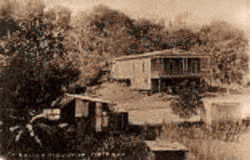
The island of Puerto Rico is very similar in geography to the island of Corsica and appealed to the many Corsican immigrants. Corsica was part of the Republic of Genoa for centuries until 1768.
Corsicans descend from a combination of ancient Corsi people from northeastern Sardinia and people who came over later from northern and central Italy (including Tuscans, Etruscans, Ligurians, and Romans) along with, to a lesser extent, Greeks and Carthaginians. It's been part of France since 1768, but retains a distinct Italian culture.
Hundreds of Corsicans and their families immigrated to Puerto Rico from as early as 1830, and their numbers peaked in the 1850s, after European unrest following the Revolutions of 1848, and environmental problems of lengthy drought. The Corsicans tended to settle in the mountainous southwestern region of the island, and Yauco attracted the majority of them.[5] As noted, the three main crops were coffee, sugar cane and tobacco. The new settlers first worked on the farms, and some saved money in order to own and operate their own grocery stores. They began to specialize in cultivation of coffee as a commodity crop.
Coffee was first cultivated in the Rancheras and Diego Hernández sectors; it was expanded to the Aguas Blancas, Frailes and Rubias sectors. The Mariani family adapted a cotton gin in the 1860s to use in mechanical dehusking of coffee. This improved the appearance of Puerto Rico's coffee beans and helped it stand out in the international coffee market.[6] By the 1860s the Corsican settlers were the leaders of the coffee industry in Puerto Rico, and seven out of ten coffee plantations were owned by Corsicans.[7]
Intentona de Yauco

The pro-independence movement raised the second and last major revolt here against Spanish colonial rule in Puerto Rico, known as the Intentona de Yauco, a.k.a. the "Attempted Coup of Yauco." The revolt, which occurred on March 26, 1897, was organized by Antonio Mattei Lluberas, Mateo Mercado and Fidel Vélez. They were supported by leaders of "El Grito de Lares", the first major independence attempt, who were in exile in New York City as members of the Puerto Rican Revolutionary Committee. During this uprising, Vélez raised for the first time what became the current flag of Puerto Rico on local soil. Local Spanish authorities had heard rumors of the revolt and acted swiftly to suppress it.[8]
Spanish–American War
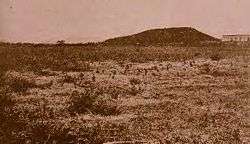
In 1898, upon the outbreak of the Spanish–American War, Guánica was a small barrio within the town of Yauco. It had 60 houses in all and was defended only by eleven members of the 4th Volante de Yauco, a Puerto Rican militia unit, under the command of Lieutenant Enrique Méndez López. When the convoy with General Nelson A. Miles, approached the barrio, Guánica lighthouse keeper Robustiano Rivera immediately alerted its residents. Nearly all the residents abandoned their homes and joined Rivera to go to Yauco, where he broke the news of the invading forces to the city's mayor. Only Agustín Barrenechea, Vicente Ferrer, Juan María Morciglio, Simón Mejil, Salvador Muñoz, Cornelio Serrano and Pascual Elena stayed to welcome the invaders.[9]
The first skirmish between Spanish/Puerto Rican and American armed forces was fought in that barrio between the Puerto Rican militia and twenty-eight sailors and Marines, under the command of Lieutenants H. P. Huse and Wood. They had come from the USS Gloucester on rafts and landed on the beach, where Lt. Méndez López and his men opened fire on the Americans. During the small battle which followed, the Americans returned fire with a machine gun and the Gloucester began to bombard the Spanish position. Lt. Méndez López and three of his men were wounded, and the militia unit retreated to the town of Yauco.
This was also the site of the first major land battle in Puerto Rico during the war between Spanish/Puerto Rican and American armed forces. On July 26, 1898, Spanish forces and Puerto Rican volunteers, led by Captain Salvador Meca and Lieutenant Colonel Francisco Puig, fought against American forces led by Brigadier General George A. Garretson. The Spanish forces engaged the 6th Massachusetts in a firefight at the Hacienda Desideria, owned by Antonio Mariani, in what became known as the Battle of Yauco of the Puerto Rico Campaign. The casualties of Puig's forces were two officers and three soldiers wounded and two soldiers dead. The Spanish forces were ordered to retreat.[10]
Earthquake in 2020
Multiple residences and structures in Yauco were damaged with a 6.4-magnitude earthquake that struck the island in the morning hours of January 7, 2020.[11] More than thirty-two residences collapsed and hundreds were structurally unsound after the earthquake struck near Yauco. To aid residents who were left without power or homeless, the National Guard was mobilized. A center for emergency operations was set up in the municipality's auditorium parking area, with air-conditioned tarps and tents for evacuated hospital patients and with food being cooked by World Central Kitchen.[12]
Hurricane Maria
Significant rainfall from Hurricane Maria, on September 20, 2017, triggered numerous landslides in Yauco, leaving entire communities cut-off.[13][14] The Yauco River caused flooding that decimated entire neighborhoods.[15]
Geography
Yauco is a mountainous municipality which is bisected by the Río Yauco. Other rivers in the municipality are the Río Chiquito, Duey Loco and Río Naranjo. Hills in the area include Mount Membrillo, the Rodadero Peak and the Curet Hill.[16]
Barrios
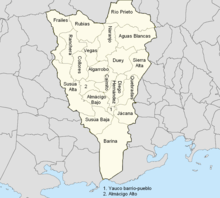
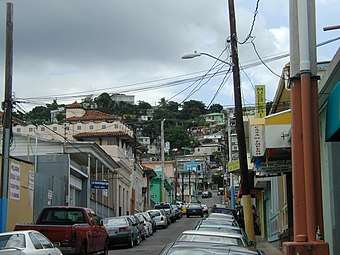
Like all municipalities of Puerto Rico, Yauco is subdivided into barrios. The municipal buildings, central square and large Catholic church are located in a barrio referred to as "el pueblo".[17][18][19]
Sectors
Barrios (which are like minor civil divisions)[20] in turn are further subdivided into smaller local populated place areas/units called sectores (sectors in English). The types of sectores may vary, from normally sector to urbanización to reparto to barriada to residencial, among others.[21][22][23]
Special Communities
Of the 742 places on the list of Comunidades Especiales de Puerto Rico, the following barrios, communities, sectors, or neighborhoods are in Yauco: Diego Hernández, Frailes, Ranchera, Sector Primitivo Irizarry in Quebradas, El Pozo, Sector Cantera, Pueblo Norte (El Cerro), and Río Prieto.[24][25]
Demographics
According to the United States Census Bureau the population of Yauco in the year 2000 was 46,384 persons, decreasing to 42,043 persons in 2010, a net loss of 4,341 people or 9.36% of its population. Its land area is 176.5 square kilometers with a population density of 238.2. The urban zone accounted for 17,186 of its inhabitants in the 2010 census.[26]
| Historical population | |||
|---|---|---|---|
| Census | Pop. | %± | |
| 1900 | 27,119 | — | |
| 1910 | 31,504 | 16.2% | |
| 1920 | 25,848 | −18.0% | |
| 1930 | 27,787 | 7.5% | |
| 1940 | 30,533 | 9.9% | |
| 1950 | 33,708 | 10.4% | |
| 1960 | 34,780 | 3.2% | |
| 1970 | 35,103 | 0.9% | |
| 1980 | 37,742 | 7.5% | |
| 1990 | 42,058 | 11.4% | |
| 2000 | 46,384 | 10.3% | |
| 2010 | 42,043 | −9.4% | |
| U.S. Decennial Census[27] 1899 (shown as 1900)[28] 1910–1930[29] 1930-1950[30] 1960–2000[31] 2010[18] | |||
Tourism
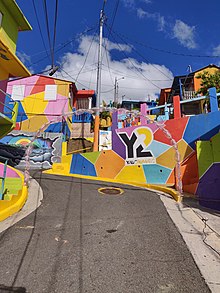
Following Hurricane Maria, in order to lift up their spirits, Yauco's artists worked on "Yaucromatic", a project to paint colorful murals throughout an entire neighborhood of Yauco.[32]
Landmarks and places of interest
There are 2 beaches in Yauco, including Playa Ballenas.[33] The places of interest in Yauco include:
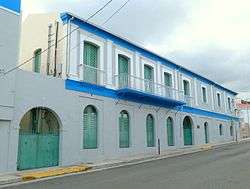
- Mansión Negroni
- Hacienda Mireia which was Hacienda La Juanita, a historic plantation, is a 50-acre coffee farm[34]
- Casa Franceschi
- Casa Agre
- Casa Cesari
- Cuesta Los Judios: next to Reparto La Esperanza it has a length of 0.21 kilometres.
- Iglesia Católica Nuestra Señora del Rosario
- Lucchetti Lake
- Nuestra Señora del Rosario Hermitage Ruins
- Plaza Fernando Pacheco
- Teatro Ideal
- Tozza Castle
- Vega Lake
- Colegio Santísimo Rosario (Most Holy Rosary School)
- Yauco Urban Park
- Playa Atolladora[35]
- Estadio Municipal Mario "Ñato" Ramírez Torres (Mario "Ñato" Ramírez Torres Municipal Stadium)
- Volkyland Volkswagen museum[36]
- Coliseo Raúl "Pipote" Oliveras Vera (Raúl "Pipote" Oliveras Vera Coliseum)
Economy
Yauco's main crops are coffee, plantains, oranges and tobacco. Yauco coffees are a revived specialty origin that, at best, display the qualities that made Jamaica Blue Mountain famous: A deep, vibrant, yet restrained acidity and balanced, gently rich flavor. However, this potentially finest of Caribbean coffees is often marred by inconsistency.[37]
Yauco also produces textiles and other light manufactured materials.
Sartorius pharmaceuticals, located in Yauco, expanded their current operations there in mid 2019.[38]
Culture
Festivals and events
Yauco celebrates its patron saint festival in October. The Fiestas Patronales de Nuestra Virgen del Rosario is a religious and cultural celebration that generally features parades, games, artisans, amusement rides, regional food, and live entertainment.[16]
Other festivals and events celebrated in Yauco include:
- Coffee Festival – February
- Christmas Festival - December
- Festival Internacional de las Culturas – December[39]
DNA Ancestry Tests
Recent genealogical DNA-based testing, which look at specific locations of a person's genome, in order to find or verify ancestral genealogical relationships or to estimate the ethnic mixture of an individual, have found significant Portuguese, Spanish, Native American, Corsican, Ireland, Scotland, Germanic Europe, Italian, North Africa, West Africa and European Jewish DNA presence in individuals who are descendants from inhabitants who were born within the geographical area of Yauco and other parts of southwestern Puerto Rico.[40]
These nationalities have significantly influenced the local culture, to include food, art, some words used in the language, customs, beliefs, and music.
Government
In 2019, Angel Luis Torres is the mayor of Yauco.[11]
Abel Nazario Quiñones of the New Progressive Party had held the office of Mayor of Yauco since 2000. He succeeded Pedro Jaime Torres by winning the 2000 general election and retained his seat in both 2004 and 2008.[41][42][43] Nazario took a 50% pay cut which was reversed in 2005, yet his current annual wage of $36,000 is the lowest for any of the 78 Puerto Rican mayors, despite Yauco not being the least-populated municipality or the one with the lowest budget.[44]
The city belongs to the Puerto Rico Senatorial district V, which is represented by two Senators. In 2012, Ramón Ruiz and Martín Vargas Morales, from the Popular Democratic Party, were elected as District Senators.[45]
Transportation
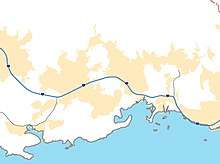
Interstate Highway PRI-2 goes through Yauco. The interstate highway is designated as such because it receives up to 90% of its funding from the US Interstate Highway System.
In 2019, there were 40 bridges in Yauco.[46] A bridge that goes over Yauco River suffered damages during 2017 Hurricane Maria.[15] A bridge that carries PR-359 would have to be demolished due to damages caused by the 2019–2020 Puerto Rico earthquakes.[47]
Symbols
Flag
The flag of Yauco consists of two horizontal stripes of equal width, black the superior and gold the inferior one. The municipal coat of arms is in the center.
Coat of arms
The coat of arms of Yauco is quartered by a central cross representing Christendom. In a silver field a gold and black boiler, with seven necks and heads of black serpents in each handle, three to the right hand, confronted with four to the left-hand side. Bordered by a checkered band in gold and black. The second and third quarters, in a field of gold, two coffee plant flowers of five leaves of silver and four red. The coffee plant flower and the coffee grains represent their cultivation in the Yauco municipality. The border of the Arms represents the beads of the rosary. The three tower crown represents its city status.
Notable people
The following is a list of people born in Yauco.
- Johnny Albino (1919–2011) – bolero vocalist
- Benny Ayala (born 1951) – 1983 World Series-winning left fielder for the Baltimore Orioles
- Ariel Castro (1960–2013) – kidnapper, rapist, torturer, and murderer of Cleveland, Ohio
- Carmelo Filardi - cartoonist who published El Mundo in 1927
- Mihiel Gilormini (1918–1988) – airman of World War II. Founded the Puerto Rico Air National Guard
- Francisco Lluch Mora (1924–2006) – poet and history professor on the city of Ponce
- Antonio Mattei Lluberas (1857–1908) – leader of the Intentona de Yauco against Spanish rule
- Héctor Andrés Negroni (born 1938) – first Puerto Rican graduate of the United States Air Force Academy
- Mike Perez (born 1964) – 1990s Major League Baseball pitcher
- Francisco Rojas Tollinchi (1911–1965) – poet and journalist.[48]
- José Semidei Rodríguez (1868–1958) – soldier in the Cuban Liberation Army in the Cuban War of Independence, later Cuban diplomat.[49]
- Ray Suarez – alderman in the 31st ward of Chicago, Illinois since 1991
Gallery
 Street in downtown Yauco
Street in downtown Yauco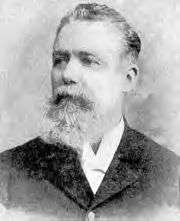 Antonio Mattei Lluberas, leader of the Intentona de Yauco
Antonio Mattei Lluberas, leader of the Intentona de Yauco.jpg) Brigadier General José Semidei Rodríguez, Cuban freedom fighter and diplomat
Brigadier General José Semidei Rodríguez, Cuban freedom fighter and diplomat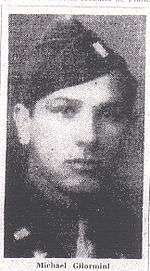 Brig. Gen. Mihiel Gilormini
Brig. Gen. Mihiel Gilormini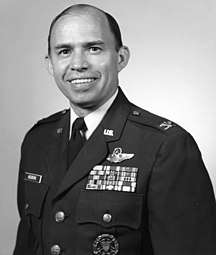 Colonel Héctor Andrés Negroni, U.S. Air Force
Colonel Héctor Andrés Negroni, U.S. Air Force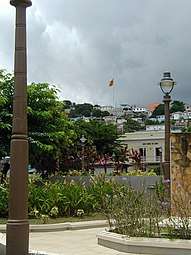 Central plaza in Yauco
Central plaza in Yauco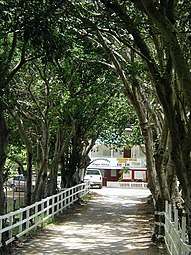 Gaby's restaurant in Yauco
Gaby's restaurant in Yauco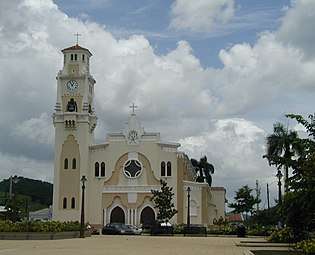 Catholic church in Yauco
Catholic church in Yauco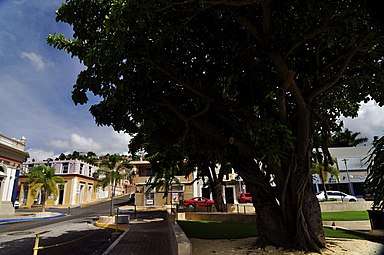 Tree in Yauco barrio-pueblo
Tree in Yauco barrio-pueblo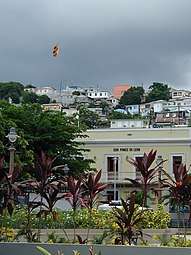 Houses on a hillside, view from Yauco barrio-pueblo
Houses on a hillside, view from Yauco barrio-pueblo
See also
- List of Puerto Ricans
- Corsican immigration to Puerto Rico
- Battle of Yauco
- Intentona de Yauco
- History of Puerto Rico
- Did you know-Puerto Rico?
References
- Yauco, Puerto Rico Archived September 23, 2012, at the Wayback Machine. Welcome.topuertorico.org.
- "LA REBELIÓN DEL CACIQUE AGUEYBANA II". Archived from the original on February 6, 2012. Retrieved May 16, 2010.
- "Land Tenure Development In Puerto Rico" (PDF). Archived from the original (PDF) on September 13, 2006. Retrieved May 16, 2010.
- "historia de Yauco". Archived from the original on March 14, 2010. Retrieved May 16, 2010.
- "A Little History of Coffee and Agriculture in Puerto Rico". Archived from the original on July 4, 2008. Retrieved August 2, 2009.
- "Café Yauco Selecto". Archived from the original on May 9, 2008. Retrieved October 4, 2008.
- "Corsican immigration to Puerto Rico". Archived from the original on February 11, 2007. Retrieved July 31, 2007.
- "Historia militar de Puerto Rico"; by Héctor Andrés Negroni (Author); Publisher: Sociedad Estatal Quinto Centenario (1992); Language: Spanish; ISBN 84-7844-138-7; ISBN 978-84-7844-138-9
- "El desembarco en Guánica". 1898 La Guerra Hispano Americana en Puerto Rico (in Spanish). Archived from the original on April 21, 2010. Retrieved August 2, 2008.
- "Battle of Yauco". Archived from the original on July 24, 2008. Retrieved July 30, 2008.
- "Colapsan al menos ocho viviendas en Yauco por fuerte sismo". El Nuevo Dia. January 7, 2020.
- "Alcalde de Yauco actualiza información de daños en su municipio". www.wapa.tv (in Spanish).
- "Preliminary Locations of Landslide Impacts from Hurricane Maria, Puerto Rico". USGS Landslide Hazards Program. USGS. Archived from the original on March 3, 2019. Retrieved March 3, 2019.
- "Preliminary Locations of Landslide Impacts from Hurricane Maria, Puerto Rico" (PDF). USGS Landslide Hazards Program. USGS. Archived (PDF) from the original on March 3, 2019. Retrieved March 3, 2019.
- "María, un nombre que no vamos a olvidar. [Maria, a name we'll never forget.]". El Nuevo Día (in Spanish).
- "Yauco Municipality". enciclopediapr.org. Fundación Puertorriqueña de las Humanidades (FPH). Archived from the original on March 27, 2019. Retrieved March 20, 2019.
- Gwillim Law (May 20, 2015). Administrative Subdivisions of Countries: A Comprehensive World Reference, 1900 through 1998. McFarland. p. 300. ISBN 978-1-4766-0447-3. Retrieved December 25, 2018.
- Puerto Rico:2010:population and housing unit counts.pdf (PDF). U.S. Dept. of Commerce Economics and Statistics Administration U.S. Census Bureau. 2010. Archived (PDF) from the original on February 20, 2017. Retrieved December 26, 2018.
- "Map of Yauco at the Wayback Machine" (PDF). Archived from the original (PDF) on March 24, 2018. Retrieved December 29, 2018.
- "US Census Barrio-Pueblo definition". factfinder.com. US Census. Archived from the original on May 13, 2017. Retrieved January 5, 2019.
- "Agencia: Oficina del Coordinador General para el Financiamiento Socioeconómico y la Autogestión (Proposed 2016 Budget)". Puerto Rico Budgets (in Spanish). Retrieved June 28, 2019.
- Rivera Quintero, Marcia (2014), El vuelo de la esperanza: Proyecto de las Comunidades Especiales Puerto Rico, 1997-2004 (first ed.), San Juan, Puerto Rico Fundación Sila M. Calderón, ISBN 978-0-9820806-1-0
- "Leyes del 2001". Lex Juris Puerto Rico (in Spanish). Retrieved June 24, 2020.
- Rivera Quintero, Marcia (2014), El vuelo de la esperanza:Proyecto de las Comunidades Especiales Puerto Rico, 1997–2004 (1st ed.), San Juan, Puerto Rico Fundación Sila M. Calderón, p. 273, ISBN 978-0-9820806-1-0
- "Comunidades Especiales de Puerto Rico" (in Spanish). August 8, 2011. Archived from the original on June 24, 2019. Retrieved June 24, 2019.
- "U.S. Census website". United States Census Bureau. Retrieved September 17, 2012.
- "U.S. Decennial Census". United States Census Bureau. Archived from the original on April 26, 2015. Retrieved September 21, 2017.
- "Report of the Census of Porto Rico 1899". War Department Office Director Census of Porto Rico. Archived from the original on July 16, 2017. Retrieved September 21, 2017.
- "Table 3-Population of Municipalities: 1930 1920 and 1910" (PDF). United States Census Bureau. Archived (PDF) from the original on August 17, 2017. Retrieved September 21, 2017.
- "Table 4-Area and Population of Municipalities Urban and Rural: 1930 to 1950" (PDF). United States Census Bureau. Archived (PDF) from the original on August 30, 2015. Retrieved September 21, 2014.
- "Table 2 Population and Housing Units: 1960 to 2000" (PDF). United States Census Bureau. Archived (PDF) from the original on July 24, 2017. Retrieved September 21, 2017.
- "Archived copy". Archived from the original on July 5, 2019. Retrieved July 5, 2019.CS1 maint: archived copy as title (link)
- "Las 1,200 playas de Puerto Rico [The 1200 beaches of Puerto Rico]". Primera Hora (in Spanish). April 14, 2017. Archived from the original on December 12, 2019. Retrieved December 13, 2019.
- "2. LIVING ROOM - Hacienda Cafetalera Santa Clara, House, Km 19,PR Rte. 372, Hacienda La Juanita, Yauco Municipio, PR". Library of Congress, Washington, D.C. 20540 USA.
- "Archived copy". Archived from the original on September 9, 2018. Retrieved July 17, 2019.CS1 maint: archived copy as title (link)
- "Archived copy". Archived from the original on November 5, 2015. Retrieved August 22, 2015.CS1 maint: archived copy as title (link)
- "Yauco, Yauco Selecto, Puerto Rico Yauco". Archived from the original on September 22, 2010. Retrieved September 8, 2010.
- "Archived copy". Archived from the original on June 19, 2019. Retrieved July 1, 2019.CS1 maint: archived copy as title (link)
- Guzmán, Sandra Torres (December 3, 2014). "Vuelve a Yauco el Festival de las Culturas". La Perla del Sur (in Spanish). Retrieved July 19, 2020.
- Genealogical DNA test
- Elecciones Generales 2000: Alcalde de Yauco Archived August 13, 2014, at the Wayback Machine on CEEPUR
- Elecciones Generales 2004: Alcalde de Yauco Archived August 12, 2014, at the Wayback Machine on CEEPUR
- Elecciones Generales 2008: Alcalde de Yauco Archived August 14, 2014, at the Wayback Machine on CEEPUR
- Alcaldes con unos sueldos de envidia Archived March 25, 2010, at the Wayback Machine from Primera Hora
- Elecciones Generales 2012: Escrutinio General Archived December 3, 2012, at the Wayback Machine on CEEPUR
- "Yauco Bridges". National Bridge Inventory Data. US Dept. of Transportation. Archived from the original on February 20, 2019. Retrieved February 19, 2019.
- Marrero, Juan. "Demolerán puente en Yauco afectado por los temblores". Metro.
- "JUSTIPRECIACIÓN DE LA OBRADE FRANCISCO ROJAS TOLLINCHI"; by Ada Hilda Martínez de Alicea; Dept. Estudios Hispánicos Pontificia Universidad Católica de PR.
- "Historia militar de Puerto Rico"; by Héctor Andrés Negroni (Author); Page 476; Publisher: Sociedad Estatal Quinto Centenario (1992); Language: Spanish; ISBN 84-7844-138-7; ISBN 978-84-7844-138-9
External links
| Wikimedia Commons has media related to Yauco, Puerto Rico. |